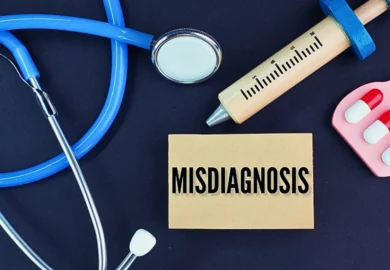Steps to prove misdiagnosis in medical malpractice involve demonstrating that a healthcare provider-patient relationship existed, the provider did not meet the required standard of care, this failure resulted in harm to you, and you experienced harm as a consequence.
Table of Contents

Proving misdiagnosis in a medical malpractice case isn’t easy. For a successful claim, you’re going to need to work with experienced attorneys. Contact Ankin Law at (312) 600-0000.
Understanding Misdiagnosis
A misdiagnosis happens when a doctor inaccurately assesses a patient’s illness or misinterprets lab results. This includes missed diagnoses where a condition is overlooked entirely, and delayed diagnoses where doctors take too long to diagnose a condition. Such errors can mean the difference between life and death, leading to unnecessary suffering, worsening health, and even fatal consequences. Every year, 7.4 million misdiagnoses occur, causing 2.6 million preventable injuries and 370,000 cases of permanent disability or death.
There are three main types of diagnostic errors:
- Misdiagnosis: This is the most common type. A healthcare provider diagnoses one condition when you actually have a different condition.
- Missed Diagnosis: Failing to identify any condition at all.
- Delayed Diagnosis: Taking too long to reach a diagnosis despite available information. A delayed diagnosis is particularly significant if earlier treatment for a disease could have changed the patient’s outcome, such as a cancer diagnosis.
Key Steps to Prove Misdiagnosis in Medical Malpractice Cases
In Illinois, proving misdiagnosis in medical malpractice claims requires demonstrating that the medical professional incorrectly diagnosed a condition that other physicians with the same level of training would have gotten right. You’ll also need to show that your condition worsened because of the lack of proper treatment, or that unnecessary medications, surgical procedures, or other treatments received due to the misdiagnosis caused you harm.
In general, for your medical malpractice claim for misdiagnosis to be successful, the four elements of negligence must exist. These are duty of care, breach of duty, causation, and damages.
The Existence of a Provider-Patient Relationship Creates a Duty of Care
Before you can hold a doctor accountable for misdiagnosis, you must first prove that a provider-patient relationship existed. This relationship establishes a legal duty of care, meaning the doctor was responsible for providing competent medical treatment. If a provider agreed to diagnose or treat you—and you relied on their expertise—that duty is in place. Without this relationship, the doctor has no obligation to you. However, once established, any failure to meet the expected standard of care can be considered negligence. Proving this relationship is the first step in any medical malpractice case involving misdiagnosis or improper treatment.
The Provider’s Negligence in Upholding the Standard of Care – Breach of the Duty of Care
Not all diagnostic errors are considered negligence. If a healthcare provider follows the accepted standard of care, they cannot be held liable for a misdiagnosis. The standard of care requires doctors to use the skills, knowledge, and procedures commonly accepted in their medical community. This is key in medical malpractice cases, as it determines whether a provider’s actions were negligent. Importantly, doctors are not required to use the most advanced or cutting-edge diagnostic methods—only those that are widely accepted and routinely used in their field.
On the other hand, if the provider fails to meet the standard of care while making a diagnostic error, they may be held liable. To prove that the provider did not adhere to the standard of care, it’s essential to have a medical expert who can explain what that standard entails and how a provider operating within that standard would have made the correct diagnosis. This often involves one of the following scenarios:
- The provider did not adhere to diagnostic guidelines set forth by recognized medical associations.
- The provider neglected to follow established practices in conducting examinations, ordering tests, or interpreting test results.
- A primary care doctor or another practitioner should have referred you to a different specialist, as your symptoms or condition were beyond their scope of expertise.
Proving Causation: Linking Misdiagnosis to Patient Harm
It’s essential to establish that the diagnostic error directly resulted in your injury. You must prove that if the correct diagnosis had been made in a timely manner, the harm would have been prevented or significantly reduced. The key is establishing a clear link between the diagnostic failure and the damage you suffered.
Medical experts play a crucial role in establishing causation by explaining how proper diagnosis would have led to different treatment and better outcomes. They can help quantify the harm by comparing your actual outcome to what likely would have happened with proper diagnosis and timely treatment.
You Must Have Suffered Harm Because of the Misdiagnosis
Simply proving that a doctor made an incorrect diagnosis isn’t enough to establish a successful medical malpractice claim. You must demonstrate that the misdiagnosis directly caused you to suffer actual harm. This harm can take various forms, including physical pain, emotional suffering, additional medical expenses, lost wages, or a worsened prognosis.
How to Gather Evidence for Your Misdiagnosis Claim
Gathering evidence for a medical malpractice case can be difficult, particularly when you’re in recovery and unsure of how to begin. There are various types of evidence that can strengthen your case.
Medical Records and Charts
Your attorney can help you in acquiring medical records, which are an important type of evidence commonly utilized. These records include a variety of documents, reports, or notes created by healthcare professionals like doctors and nurses regarding the specific incident. They may feature information on diagnoses, treatment plans, medication adjustments, progress notes, discharge summaries from hospitals, and more. Medical records are essential as they establish a precise timeline of events leading to the injury or illness, along with details of any subsequent care provided after the incident.
Expert Testimony
Medical expert testimony forms the backbone of almost every misdiagnosis case. These healthcare professionals with specialized knowledge and experience serve as crucial witnesses who can explain complex medical concepts in terms that judges and juries can understand. A qualified medical expert can establish the standard of care that should have been followed, identify how your doctor deviated from this standard, and draw the critical connection between the misdiagnosis and your resulting harm. They review your medical records, test results, and treatment history to provide an informed opinion about what a reasonable physician would have done differently in your situation. Experts can also quantify the impact of the misdiagnosis by comparing your actual outcome to what likely would have occurred with proper and timely diagnosis. Courts give significant weight to this testimony, making the selection of a credible, well-qualified expert with relevant specialization in your specific medical condition an essential strategic decision that can dramatically influence the outcome of your case.
Medical Expense Receipts and Employment Records
Your attorney will assess your medical bills and receipts to determine your historical and ongoing medical expenses. Additionally, your employment records, such as pre-injury pay stubs, tax returns, and a letter from your employer, will be used to establish and verify your lost wages.
Why a Medical Malpractice Lawyer is Crucial for Proving Misdiagnosis
If you’re considering a medical malpractice lawsuit, it’s crucial to enlist the support of a medical malpractice lawyer.
A lawyer will evaluate key factors, including the severity of your injury, its impact on your quality of life, financial losses, and lost income. They’ll handle every aspect of your case, working toward the best possible outcome.
Liability may extend beyond your doctor. A lab technician, medical device manufacturer, or hospital could also be responsible. Your lawyer will analyze medical records, identify all negligent parties, and pursue multiple claims if necessary.
Navigating insurance negotiations alone can be overwhelming—insurers prioritize their bottom line, not your recovery. Your attorney will handle all legal documents, communications, and negotiations, ensuring your claim is presented with accuracy and strength.
Obtaining an Affidavit of Merit
Unlike standard negligence cases, Illinois law requires an affidavit of merit for medical malpractice cases. Under the Healing Arts Malpractice Act, you must submit a document with your lawsuit that confirms you have consulted a medical professional. This document is known as an affidavit of merit. It must demonstrate that you have (or had) a medical condition, that another medical professional would have correctly diagnosed your issue, and that you have a medical malpractice claim.
A lawyer experienced in handling misdiagnosis cases typically has established relationships with various healthcare providers. This lawyer can assist you in finding a healthcare professional to validate your medical condition and help prepare a compliant affidavit of merit.Did you or a loved one suffer harm caused by misdiagnosis? Filing a medical malpractice claim can help you recover compensation for your medical bills, lost wages, and pain and suffering. Contact us to learn more about your legal options. With over 150 years of combined experience representing injured patients throughout Illinois, Ankin Law can help you recover maximum compensation for your losses.



